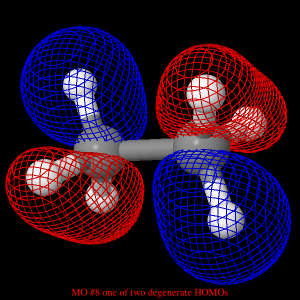Once the molecule file is fully
loaded the image at right will become live. At that time the
"activate 3-D" icon ![]() will disappear.
will disappear.
Making
a Jmol ScriptButton Page
This
tutorial will step you through making this page, which compares
the
shapes of the degenerate pair of HOMOs found for ethane.
If
you
started on the main
tutorial page you have probably completed the preparation
steps.Preparation:
- Download the data file ethane-staggered-3-21G.log.
- Open this file in the Jmol application.
- Open the Jmol Web Page Maker dialog by clicking on the
"Export to Web Page..." icon
 or by selecting "Export to Web Page..." within
the "Export" submenu of the "File" menu.
or by selecting "Export to Web Page..." within
the "Export" submenu of the "File" menu. - Select the ScriptButton template by clicking on the ScriptButton tab.
- Enter the necessary information into the fields on the left hand side of the dialog(see general set up)
- Open the scripting console (right mouse button, control-click on one button mouse, > Console).
- Navigate to the last frame of the file. Use either the command "frame 1.9" or the pop-up menu (right mouse button > model > 1.9).
- Turn on spinning (right mouse button > Spin > On).
- Display MO #8. Use either the command "mo 8" or the pop-up menu (right mouse button > Surfaces > Molecular Orbitals > 1..25 > 8 -0.4773)
- Add the annotation at the bottom using the echo command: "set echo bottom center; echo "MO #8 one of two degenerate HOMOs"".
- Save this view by clicking on the "Add Present Jmol State as Instance..." button near the bottom right of the dialog.
- Enter the text you want to appear in the button in the small dialog that pops up. I suggest "MO 8". Click "OK". This will add this instance to the list in the large window on the right side of the dialog box.
- Display MO #9. Use either the command "mo 9" or the pop-up menu (right mouse button > Surfaces > Molecular Orbitals > 1..25 > 9 -0.4773)
- Change the annotation to reflect the change in orbital using the command: "echo "MO #9 one of two degenerate HOMOs"".
- Save this view by clicking on the "Add Present Jmol State as Instance..." button.
- Enter the text you want to appear in the button in the small dialog that pops up. I suggest "MO 9". Click "OK". You should now have two instances in your instance list.
- Turn off the display of MO #9 with the command: "mo off".
- Create the cyan display of MO #8 with following commands:
- "isosurface homoa mo 8 mesh nofill;"
- "color isosurface cyan;"
- Create the yellow display of MO #9 with the equivalent commands:
- "isosurface homob mo 9 mesh nofill;"
- "color isossurface yellow;"
- Change the annotation to reflect what is now displayed using the command: "echo "Cyan (MO#8)|Yellow (MO#9)"". The line right before the word "yellow" is a vertical line, usually found as the shift character for the backslash "\". This vertical line causes everything after it to appear on a new line.
- Save this view by clicking on the "Add Present Jmol State as Instance..." button.
- Enter the text you want to appear in the button in the small dialog that pops up. I suggest "HOMO Comparison". Click "OK". You should now have three instances in your instance list.
- Double check your entries in the text boxes on the left side of the dialog box (you may not have reset them since making a different web page).
- Click on the "Save .html as ..." button near the bottom left. Choose a location and name for the page. A directory of that name will be created in the location you choose. It will contain many files.
- Check that your page is OK. If necessary move a copy of
the
whole directory just created to your test directory (see
instructions
on testing locally). Open the .html
file. It should look like this
 .
. - Add the descriptive text that appears in this left hand scrolling window. You only need to edit the .html document.
- Open the .html document in your favorite WYSIWYG Web page editor. Some suggestions are:
- KompoZer
 (open source, not
recommended as of
version 0.8 because bugs damage javascript),
(open source, not
recommended as of
version 0.8 because bugs damage javascript), - SeaMonkey
 (Open source. You must check "Preserve original
source formatting" in Preferences > Composer. This is the author's
favorite editor),
(Open source. You must check "Preserve original
source formatting" in Preferences > Composer. This is the author's
favorite editor), - Amaya
 (open source, complete, but harder to use).
(open source, complete, but harder to use). - Be
careful when editing not to do anything to the picture of
Jmol at right
or the buttons.
It is
possible to damage the javascript so that the page will
not work. Note you can safely change the name of the buttons.
- Once the page is the way you want it copy everything in
the directory containing this file to your web server except for the
jsmol directory. Make sure to put it in the appropriate
directory on your server.
You may look at any of these intermediate views again by clicking on the appropriate button.
Page skeleton
and JavaScript generated by export to web function using Jmol 14.1.5 2014-01-09
20:04: on Jan 22, 2014.
This will be the viewer 

If your browser/OS
combination is Java capable you will get snappier performance
if you use Java.